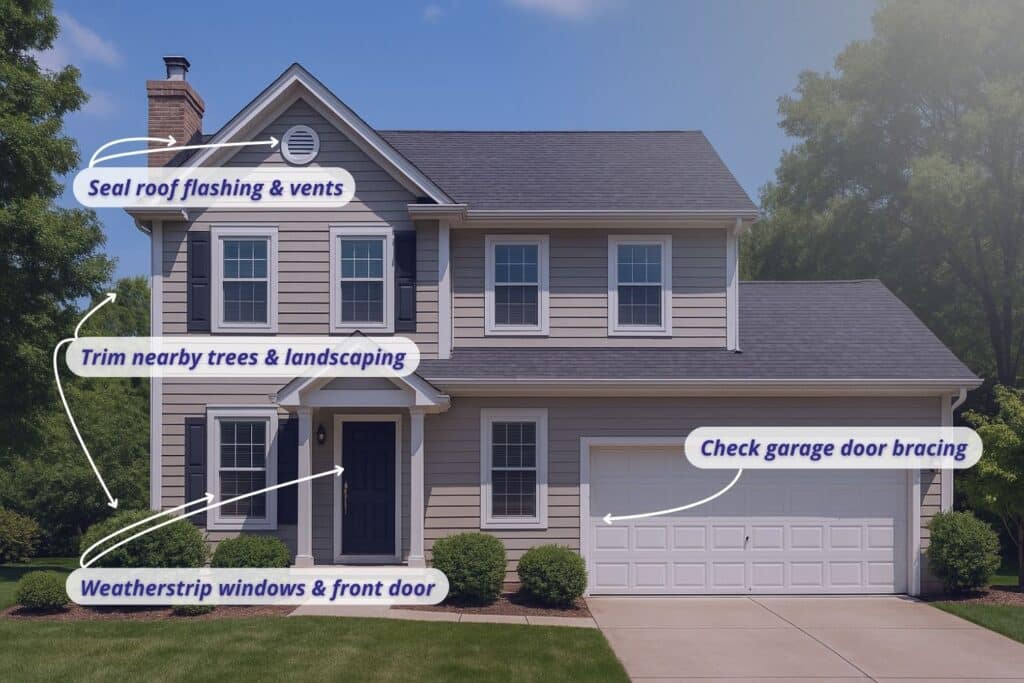Tornado season seems to hit harder each year. If you’re a homeowner in a high-risk zone, you’ve probably wondered whether tornado-proof homes are really possible. The short answer is that no homes are completely tornado-proof, but you can absolutely take steps to make your house stronger, safer, and more storm-resistant.
This guide walks you through what actually helps protect a home during a tornado, what doesn’t, and how the right upgrades can reduce damage and keep your family safer.
Start With the Roof
Most tornado damage starts at the roof. Once the roof lifts or tears away, the rest of the home becomes exposed to wind and flying debris. That’s why the roof should be your first focus when trying to create a tornado-resistant structure.
One of the most effective ways to strengthen your home is with a FORTIFIED Roof™. This system was developed by the Insurance Institute for Business & Home Safety (IBHS) and is designed to prevent common types of roof failure during high-wind events.
A FORTIFIED Roof includes:
- Stronger attachments that keep shingles in place
- A sealed roof deck that blocks water intrusion if shingles are lost
- Improved edges to stop wind from peeling off layers
- Materials tested to withstand winds up to 130–150 mph
According to IBHS, homes with FORTIFIED Roofs experience less damage from windstorms compared to those built to standard codes.

Can You Upgrade an Existing Roof?
Yes, you can upgrade your current roof to meet FORTIFIED standards. You don’t have to wait until a full roof replacement is needed.
A certified inspector can assess your existing roof and recommend improvements. These upgrades may include re-nailing decking, adding sealant barriers, or replacing edge materials with stronger options.
A FORTIFIED Roof retrofit typically ranges from $3,000 to $15,000, depending on roof size and condition. While this might sound like a big investment, many homeowners report lower insurance premiums after the upgrade.
Don’t Forget Windows, Doors, and Your Garage
Even if your roof holds strong, weak points like windows, doors, and the garage can lead to major damage.
Here’s what to check:
- Windows: Impact-rated glass or storm shutters can prevent shattering from flying debris.
- Entry doors: Reinforce door frames, replace old hardware, and make sure they seal tightly.
- Garage doors: Unbraced garage doors are one of the first things to fail. You can install a bracing kit or upgrade to a wind-rated door.
A garage door bracing kit costs about $150 to $300 and can make a big difference during high winds.
Consider a Safe Room or Shelter
If you live in a tornado-prone area, a safe room gives you a secure place to ride out a storm, even if the rest of the house takes damage.
Safe rooms can be built inside your home, often in a bathroom, closet, or hallway. They’re anchored to the foundation and made from reinforced concrete or steel.
A FEMA-compliant safe room usually costs between $3,000 and $9,000, depending on size and materials.
Even if you’ve taken steps to improve your roof or windows, a safe room gives you extra peace of mind when a tornado warning hits.
What Doesn’t Help Much
Plenty of well-meaning advice gets passed around, but not all of it works. Here are a few common myths:
Taping windows does not stop them from breaking.
Opening windows to equalize pressure is not only false, but dangerous.
“Tornado-proof” claims without any real standards or certification are often just promotional.
Real protection comes from building science, tested materials, and certified construction practices. That’s why working with professionals who understand what actually works is so important.

Other Recommended Maintenance
Tornado-proofing a home isn’t just about big upgrades. Regular maintenance helps reduce damage and keep systems strong.
- Get your roof inspected yearly, especially before and after storm season
- Seal flashing, vents, and seams to prevent water leaks during high winds
- Trim trees and secure outdoor items to reduce flying debris
- Check your garage door bracing and make sure it’s in good condition
- Weatherstrip doors and windows to help reduce internal pressure during storms
These simple tasks can support bigger upgrades and help your home perform better under stress.
When to Call a Professional
You don’t need to figure all this out alone. A certified inspector can assess your home’s current storm readiness and recommend the most effective upgrades.
Consider calling a professional if:
- Your roof is more than 10 years old
- You’re planning a roof replacement
- You live in a tornado-prone region like North or Central Texas
- You want to pursue a FORTIFIED certification
- You’re buying or selling a home and want to understand its vulnerabilities
KO Inspections is certified to perform FORTIFIED Home™ evaluations and can walk you through the process. Whether you’re just getting started or ready to move forward with upgrades, we’ll help you protect what matters most.
Conclusion
While no homes are completely tornado-proof, the right improvements can reduce damage and protect your family. Start with the roof, then address other vulnerable areas like windows, doors, and the garage. If possible, consider adding a safe room for the highest level of protection.
The key is to work with professionals who know how to apply the right standards and upgrades. At KO Inspections, we’re here to help Texas homeowners build safer homes that can better stand up to the next storm.
Ready to learn how your home stacks up? Schedule an evaluation with KO Inspections today.

